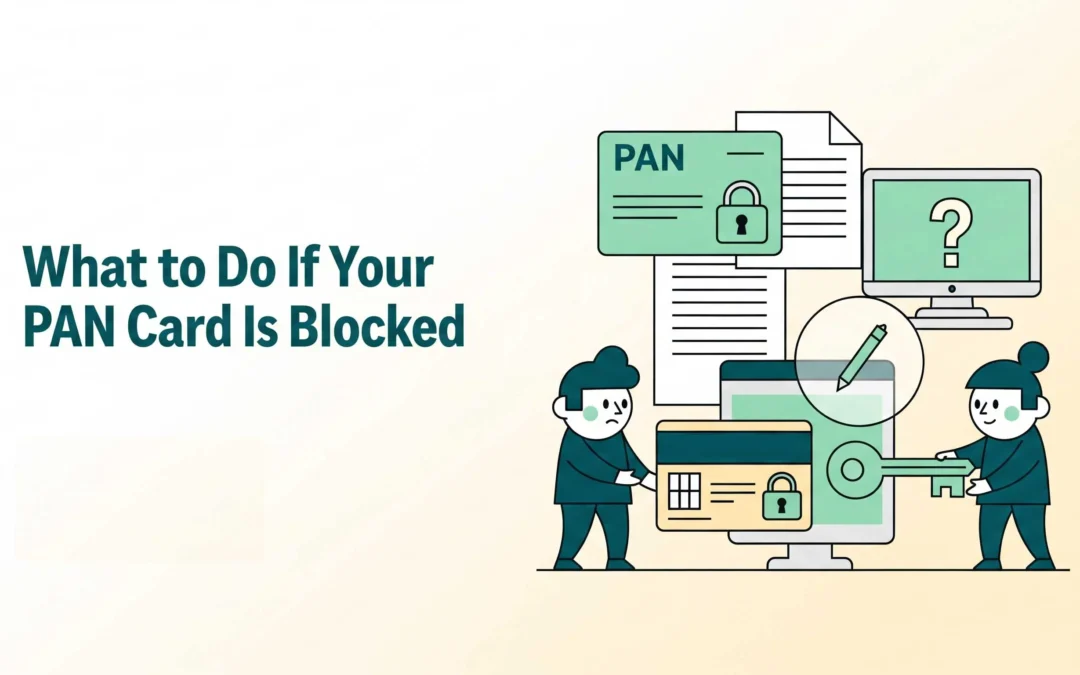As a citizen of India, it is important to ensure that you have all the documents updated. Some of these documents include Aadhaar card, PAN card, Voter ID for individuals above 18 years, etc. However, in some cases, even after having these IDs, people fail to keep them updated, which leads to their blocking. This can hinder your way of handling your finances, like filing ITR or trading.
In this article, you will learn about the reason why your PAN card may be blocked and the steps you need to take to reactivate it.
Understanding Why Your PAN Card Is Blocked
Non-linking with Aadhaar is the most frequent cause of PAN card blocking. Your PAN may become inoperative, which means it is technically blocked for financial and tax-related activities, if this link is not completed by the deadline.
Other possible reasons are as follows:
- Possessing several PANs, which is against the law.
- PAN-Aadhaar details that contain errors or inconsistencies (such as a mismatched name or date of birth).
- The Income Tax Department has identified suspicious transactions.
How to Reactivate a Blocked PAN Card?
Here’s a step-by-step guide on how to reactivate your PAN card if it has been blocked:
1. Check the PAN Status Online
It is essential to confirm the status of your PAN before taking any step:
- Go to the Portal for Income Tax e-Filing.
- In the Quick Links section, click on “Verify Your PAN.”
- Provide details such as your date of birth, full name, PAN number, and mobile number.
- You can check if your PAN is valid, inactive, or active.
2. Link Aadhaar and PAN
The lack of a link between these two cards can result in the blocking of the PAN.
To link Aadhaar and PAN:
- Visit the e-Filing Portal.
- From the homepage, select the option to “Link Aadhaar.”
- Ensure you enter your correct name according to Aadhaar and the PAN, along with the Aadhaar number.
- If you link after the deadline, use “e-Pay Tax” to pay the ₹1,000 late fee.
- Finish the OTP verification.
- Wait for 7 to 30 days for your PAN-Aadhaar status to update.
3. Correct Mismatched Details (If Aadhaar Link Fails)
There are two choices available to you:
- PAN Details Update: To submit a correction request, use UTIITSL or NSDL and upload the required documentation such as a birth certificate, passport, or Aadhaar.
- Update Your Aadhaar Information: To update your demographic information, visit the UIDAI Portal or an Aadhaar Seva Kendra in your area.
4. Turn in duplicate PAN cards
It is illegal to possess multiple PAN cards. Give up the extra PAN right away if your card has been blocked because it is duplicated.
How to turn in a duplicate PAN:
- Download the form titled “Request for New PAN Card and/or Changes or Correction in PAN Data.”
- Decide which PAN is correct and you want to keep.
- Send it in online via UTIITSL/NSDL or offline at a PAN service centre.
- After processing, you will receive a surrender acknowledgement.
5. Wait for Reactivation
You will have to wait for your PAN to be reactivated after linking Aadhaar, making the payment, or updating information.
- The processing requires 7 – 30 business days.
- Use the portal’s “Verify PAN” service to check status once more.
Consequences of Not Reactivating Your PAN Card
1. Inability to file income tax returns (ITR)
This is one of the consequences of not reactivating your PAN card that your ITR filing will not be accepted by the Income Tax Department.
- No legitimate PAN = Invalid ITR = Non-compliance
- Might result in tax department notices
- Refunds may be denied or delayed.
2. Increased TDS Deduction Rate
Even if your actual tax slab is lower, one of the most expensive outcomes is having TDS (Tax Deducted at Source) deducted at a flat rate of 20%. In addition to having an impact on your cash flow, this makes it more difficult to recover excess TDS because you can’t file an ITR until your PAN is reactivated.
3. Not Being Able to Use Essential Financial Services
If your PAN is inactive, you lose access to numerous crucial services, such as:
- Creating new accounts with banks
- Applying for a loan or credit card.
- Buying stocks, mutual funds, or insurance.
- Purchasing or disposing of property valued at more than ₹10 lakh
4. Loss of Access to Trading and Investment
If the PAN associated with your trading accounts, mutual fund investments, or Demat account is not active, your accounts may be frozen or suspended. This may result in:
- Not being able to access your portfolio
- Unable to purchase or sell stocks
- Restrictions on adding funds or redeeming assets.
5. High-Value Transaction Difficulties
PAN is required for high-value transactions like:
- Over ₹50,000 in hotel bills
- Jewellery purchases exceeding ₹2 lakh
- Exchange of foreign currencies
- Large withdrawals or deposits of cash
Bottomline
The conclusion can be drawn that it is essential to have your PAN card active and updated. There are various consequences if the PAN card is blocked, like, inability to file ITR, difficulty in trading, difficulty in higher value transactions, etc. It is important to follow the steps stated above to check the status of your PAN card time to time and reactivate it in case of deactivation.
It is for the betterment of the individuals that they ensure they have proper documentation ready in case of an emergency.


